Originated in China, Chinese Porcelain has a history of over 4000 years. The Chinese porcelain was preceded by the primitive celadon, which was developed based on the Chinese pottery. The earliest Chinese porcelain was the primitive celadon excavated in the Dongxia Fenglongshan Cultural Ruins of Shanxi province, dating back to 4200 years ago. Chinese porcelain techniques and skills were much better and more advanced in China's long history, forming a complete porcelain-making system. It became an essential part of Chinese culture.
Although the primitive celadon already appeared in the Neolithic Period, the earliest Chinese porcelain celadon was born in the Eastern Han Dynasty.
Unlike the previous primitive celadon, the typical works of the Han Dynasty primitive celadons were only glazed in the upper part with the red and black lower part exposed to air. One example of such works is the celadon discovered in the No.1 Tomb of Mawangdui Ruins in Changsha, Hunan dating back to the Western Han Dynasty.
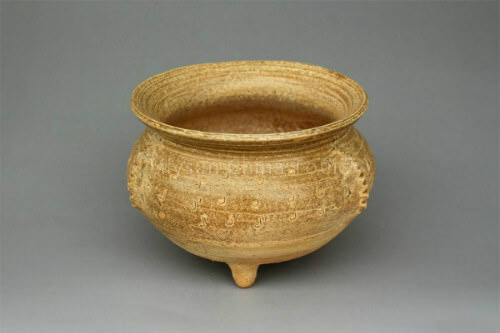
The celadon produced in Han Dynasty was further developed in Three Kingdoms and two Jin Dynasties. Many celadons are dating back to the Three Kingdoms Period and Western and Eastern Jin Dynasties excavated in the areas centered in Zhejiang. These celadons are called Guyue Porcelain. The
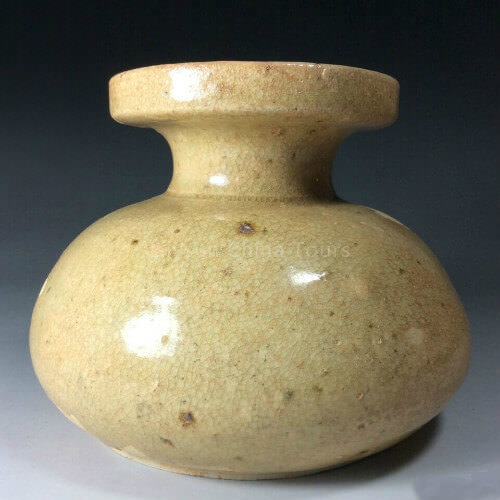
In the Southern Dynasties, the celadon still existed, but the special vessels used in tombs disappeared. Most celadon works were used in daily lives. The kilns all over the country began to make their featured porcelains, among which the Deqing Kiln in the northern Zhejiang province was the representative. Since the Eastern Jin Dynasty, the southern China people began to produce black glazed porcelain.
In the Northern Dynasties, there was no representative celadon discovered. Until the Northern Wei Dynasty, the lead-glazed potteries were made to be burial objects. In the Eastern Wei Dynasty, black porcelains and blue porcelains appeared. Later, white porcelain appeared in Northern Qi State. In comparison, no large-scale kilning activity was found in the Western Wei Dynasty and its successor Northern Zhou State.
The Sui and Tang dynasties continued to produce and develop the previous celadon, white porcelain, black-glazed porcelain, and lead-glazed porcelain. By the end of the 8th century, china had become part of people's life. Meanwhile, ceramics became one of the products exported overseas. Many celadon and white porcelains were discovered in Southeast Asia and West Asia. One of the representatives of Tang ceramics is the gorgeous Tri-color Glazed Pottery.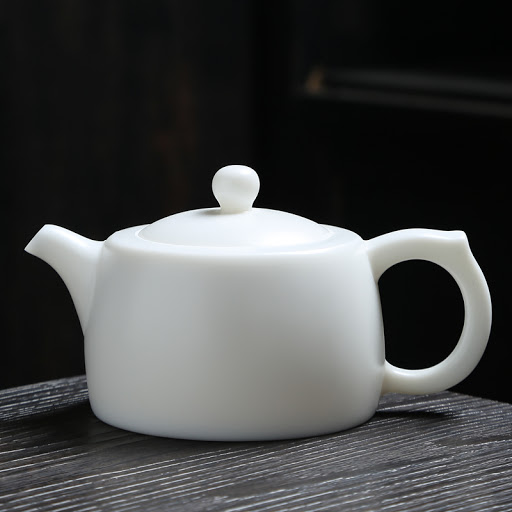
The world-famous Tri-color Glazed Pottery is a kind of lead-glazed pottery with porcelain body fired in high temperature and the glaze surface fired in low temperature. 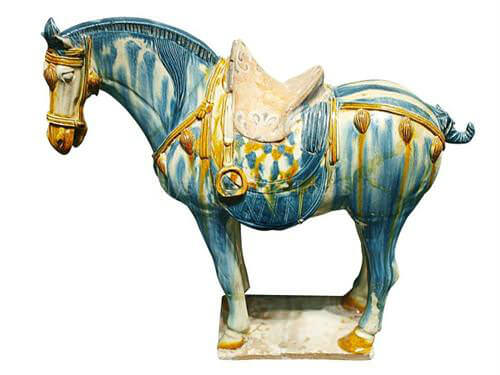 It appeared in the early Tang Dynasty, prospered in Middle Tang Dynasty, and came down with the end of the Great Tang. The kilns produced the Tri-color Glazed Pottery were mainly located in central China areas centered in Chang'an (current Xi'an) and Luoyang. Those Tri-color Glazed Potteries were mainly used for funeral products, but a small amount was for daily use and exported overseas.
It appeared in the early Tang Dynasty, prospered in Middle Tang Dynasty, and came down with the end of the Great Tang. The kilns produced the Tri-color Glazed Pottery were mainly located in central China areas centered in Chang'an (current Xi'an) and Luoyang. Those Tri-color Glazed Potteries were mainly used for funeral products, but a small amount was for daily use and exported overseas.
The Tang Tri-color Pottery was not limited to three glazed colors; it also includes the combination of two, three, or over three kinds of glaze colors. The lead glaze used in the Tang Dynasty was fluid, which could form ever-changing colors, making the surface variegated. Meanwhile, the techniques of applique and "Bala" were applied, greatly enriching the porcelain's ornamental features. Besides the matrass, binaural dragon bottles, phoenix vases, and teapots, there were also many human or animal-shaped potteries in tri-color glazed potteries.
Song Dynasty is the heyday of ceramic development, and the porcelains produced were exquisite and elegant. The technological advances were unprecedented and hard to imitate nowadays. There were five renowned kilns in China, namely the Ru Kiln, Jun Kiln, Guan Kiln, Ge Kiln, and Ding Kiln.
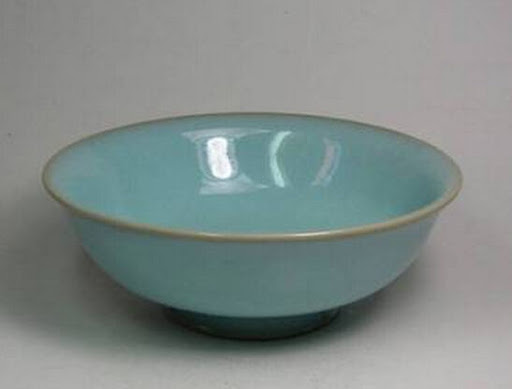
Ru Kiln was the first official kiln established in the late Northern Song Dynasty and lasted less than 20 years. The site is in the Ruzhou of Henan province, thus the name Ru kiln.
Ru kiln mainly produced blue china. The porcelains produced in Ru kiln have thin carcass and thick glaze layers, which feel like a jade-like texture. Most of these porcelains were modeled after the shapes of ancient bronze vessels. There were less than 100 pieces of such porcelains left today, making them very valuable.
Jun Kiln has two branches, one for imperial use and the other for commons. 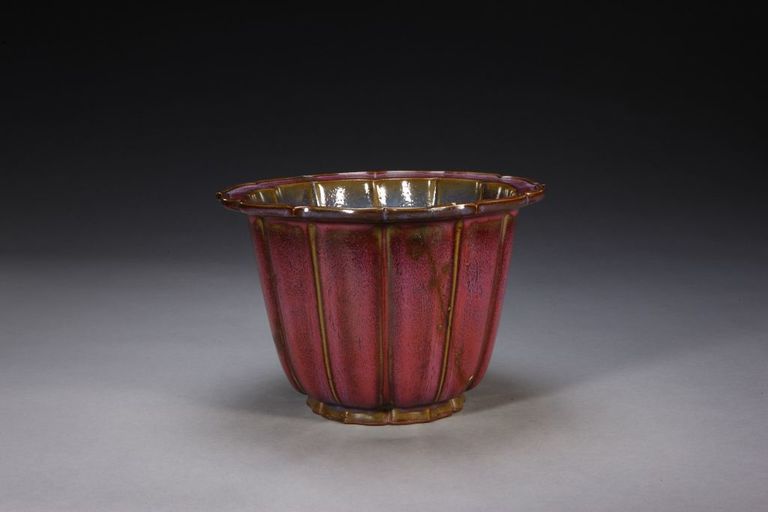 It’s the second official kiln built after the Ru Kiln.
It’s the second official kiln built after the Ru Kiln.
The porcelains produced in Jun Kiln are fired twice. They are bisque fired first and then fired again after being glazed. The glaze color is a specialty. All kinds of colors like red, blue, white, and purple are fused together like a rosy cloud. During the making process, the copper vapor was mixed into the ingredients to create such gorgeous color. This is an excellent invention in Chinese ceramics called “Transform of Kilning." Meanwhile, the thick layers of glaze will crack during the firing. The glaze fillings will come out and fill these cracks, forming regular fluid lines a lot like the crawling trace of earthworm in the mud; thus, these lines are also called “Pattern of Earthworms Crawling."
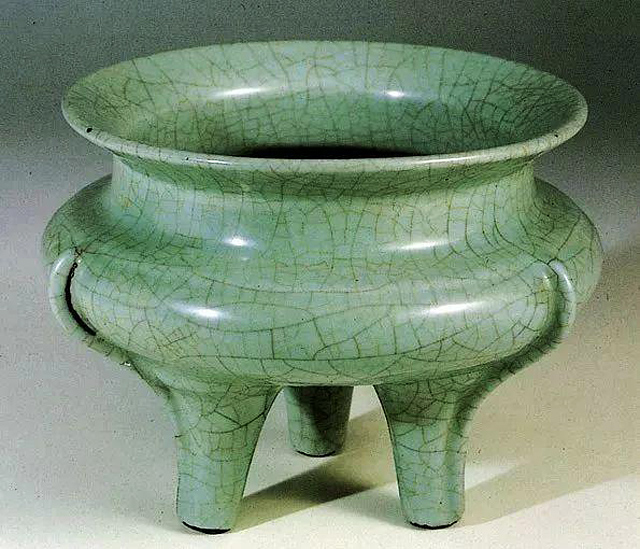
It is unclear where exactly the Guan Kiln was built. The Guan Kiln mainly made Blue china with moon white, light greenish-blue, and green as popular colors. The porcelains produced here have a thick carcass, and the glaze surfaces have big glazed patches. The bottom of the porcelains are not glazed, and the mouth part has a thin layer of glaze, which is the typical feature of ceramics in Guan Kiln. The Guan Kiln porcelains are priceless as there are few discovered today.
The site of Ge Kiln is still undiscovered so far. There are a few speculations but no consensus.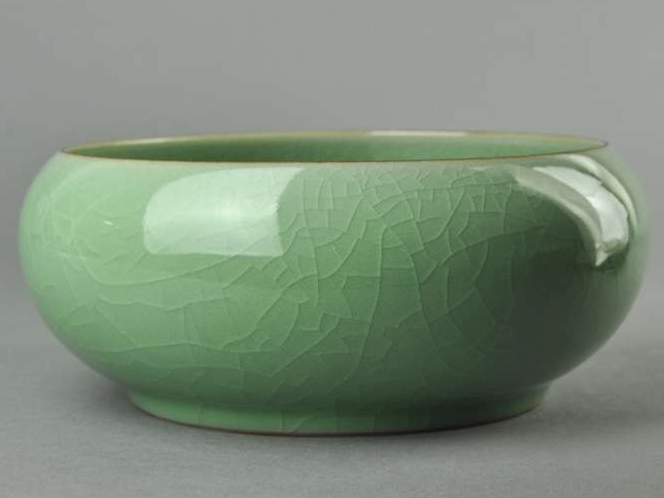
The ceramics' prominent feature in Ge Kiln is that the glaze surface has a neat gracked glaze. The small ones are called “roe pattern," the car-shaped ones are called “crab claw pattern," and the same sized ones are called “hundredfold crackle." The small patterns are in golden color, and the big patterns are black.
The porcelains produced in Ge Kiln can have a thick or thin carcass, and the major glaze colors are light greenish-blue, moon white, and cream-colored. The ones with glaze surface as fine as human skin are the best products.
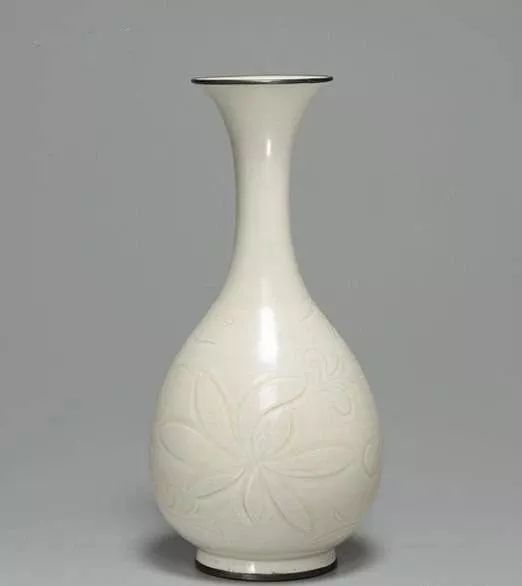
As one of the most famous kilns in the Song Dynasty, Ding Kiln is a folk kiln established initially in Tang Dynasty, prospered in Northern Song Dynasty, and ended in Yuan Dynasty, spanning over 700 years. The Ding Kiln sites are mainly distributed in Quyang county (ancient Dingzhou) of Hebei province.
Ding Kiln mainly produced delicate white and black glazed porcelain. The patterns differ in a thousand ways; some were knife carved, some were scraped with a needle, and some were made with other special skills. In the excavated porcelain pieces from Ding Kiln, some were carved with characters of “官” or “尚食局." The former character means that the porcelain was made by the official kilns, while the latter indicates that the porcelain was produced in court kilns.
In the Yuan Dynasty, the development of world-famous Blue and White Porcelain reached a prime time. The Blue and White Porcelain is a kind of underglaze color. First, the shaped vessel is bisque fired and applied with the pigment-containing cobalt oxide to make patterns. 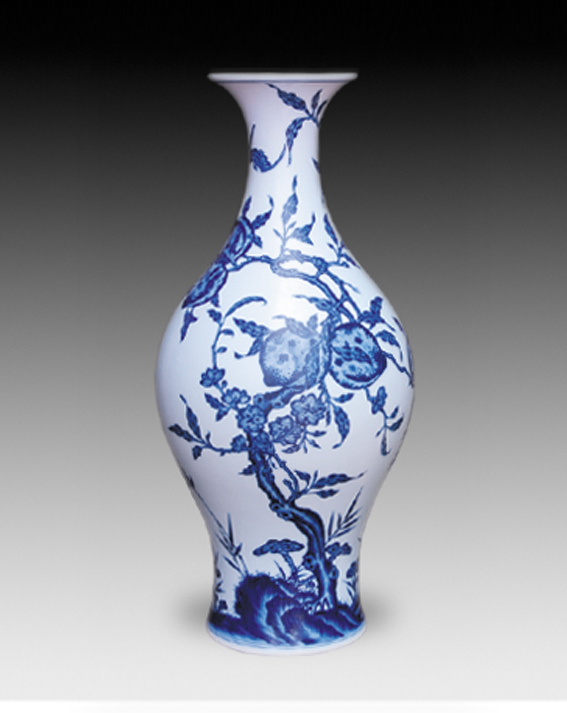 After the painting is completed, the hyaline glaze is applied, and then fire the vessel again at high temperatures to make the color cyan. As the pigment-containing cobalt oxide was mainly imported from West Asia, the color was also called "Hui Cyan" (the Islamic Cyan).
After the painting is completed, the hyaline glaze is applied, and then fire the vessel again at high temperatures to make the color cyan. As the pigment-containing cobalt oxide was mainly imported from West Asia, the color was also called "Hui Cyan" (the Islamic Cyan).
In addition to the pigment-containing cobalt oxide, the red copper pigment (underglaze red) was also used in the Yuan Dynasty to make Blue and White Porcelain. As the copper pigment is easy to vaporize, making it hard to produce the bright red color, the Underglaze Red Porcelains made at that time were mainly dark red.
The Yuan Dynasty porcelains are mostly big with a diameter over 40cm. The historians believe it was because the Blue and White Porcelains were mainly exported to West Asia areas where the big plates were commonly used to offer food. The patterns on the Blue and White Porcelains are still traditional patterns like dragons, phoenixes, human figures, peonies, and plants, and the porcelain body is usually fully covered with those exquisite patterns.
The representative kilns in the Ming Dynasty were the Official Kiln (Imperial Ware Factory) and the Jingdezhen Kiln, which also supplied porcelains to the court. Although the Cizhou Kiln in North China and Longquan Kiln in South China still existed, almost all the important porcelains were produced in Jingdezhen Kiln and other small folk kilns.
Jingdezhen Kiln appeared in Five Dynasties, developed in the Song Dynasty, and produced a lot of Blue and White porcelain at that time. In Ming and Qing Dynasties, the Jingdezhen Kiln became the center of the Chinese ceramic industry. The primary reason is that Jingdezhen (in Jiangxi province) has the pottery clay as raw materials, wood, water, and convenient water transplantation.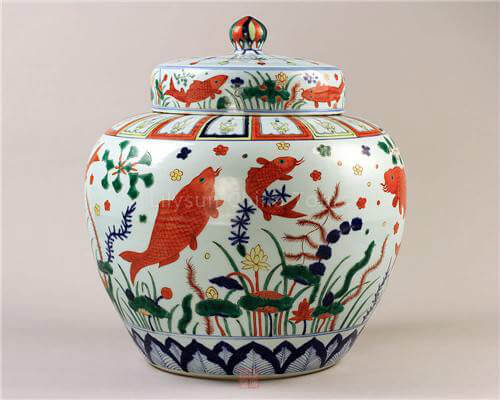
According to the excavations in Jingdezhen kiln sites, the Ming government began to set official kilns in Jingdezhen at the latest in Yongle Emperor's reign. The Ming government compulsively ordered people to labor in these kilns. People were classified into several classes like citizens, armymen, craftsmen, and pariahs. The potters belonged to craftsmen. Every four years, the craftsmen families had to provide laborers to work in official kiln and lasted for three months. In Chenghua’s reign, the policy changed that people could be free from duty if they submit a specific tax amount. After Jiajing’s Reign (1522-1566), the demand for porcelain grew so much that the official kilns began to employ folk kilns.
In the Ming Dynasty, the Jingdezhen Kiln mainly produced Blue and White Porcelain and Faience. Most of them were exported to Southeast Asia and European countries. Besides those two mainstream porcelains, single color porcelains like white porcelains were still produced. Although some Ming-era scholars believed that the white porcelains were better, and the blue and white porcelains and faience were raffish, the ceramics exported overseas were mainly the Blue and White Porcelains and Faience. Meanwhile, domestic ceramics' decorations were mostly chromatic, making the blue and white porcelains and faience the dominating ceramics.
The Qing Dynasty ceramics are the epitome of ancient Chinese ceramics. The major production center was still the Jingdezhen Kiln. After the death of the Wanli Emperor in the Ming Dynasty, the Jingdezhen official kiln was abandoned until the Kangxi Emperor’s reign (1681) in Qing Dynasty. The Jingdezhen ceramics were revived and prospered again in the Kangxi, Yongzheng, and Qianlong’s reign. The most popular ceramics at that time were the famille-rose Porcelain and enamel painted porcelain. Besides the traditional celadon glaze and black glaze, many other kinds of glazes were developed. Therefore, the firing technique and painting skills of Qing-era ceramics reached an unprecedented level and represented the highest level of ancient Chinese ceramic techniques. However, entering the 19th century, the quality of ceramics lowered with the domestic turbulence.
In the last years of Kangxi's reign, a new technique of famille rose appeared.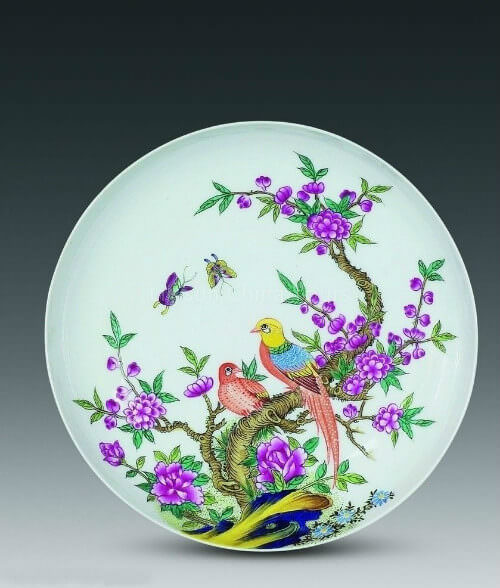 It was made by mixing the quartz powder and lead powder first and then add various pigments to the mixture. The methods used in famille rose and enamel is similar. The difference lies in that the famille rose porcelains were made completely in Jingdezhen from the shaping, firing, and glazing. While the enamel porcelains were shaped and fired in Jingdezhen kiln, the court painters must make the paintings. For example, the imported materials like the golden-red containing gold were applied, and the western painting styles were fused. Thus, the enamel painted porcelains had higher artistic values.
It was made by mixing the quartz powder and lead powder first and then add various pigments to the mixture. The methods used in famille rose and enamel is similar. The difference lies in that the famille rose porcelains were made completely in Jingdezhen from the shaping, firing, and glazing. While the enamel porcelains were shaped and fired in Jingdezhen kiln, the court painters must make the paintings. For example, the imported materials like the golden-red containing gold were applied, and the western painting styles were fused. Thus, the enamel painted porcelains had higher artistic values.
The works of enamel painted porcelains are mainly small objects like bowls and dishes, while the famille-rose porcelains from Jingdezhen are big vases. Lastly, the old-fashioned five -color pigments and famille-rose pigments were applied in the famille rose porcelain, but almost no such pigment was used in enamel painted porcelains.
Chinese ceramics has a long history; each has its unique ceramics representing the development level of that time. Nowadays, Chinese porcelains part of people’s daily life.
Copyright © 2019 Lily Sun China Tours International, Inc. Terms &conditions | Privacy Policy | Sitemap